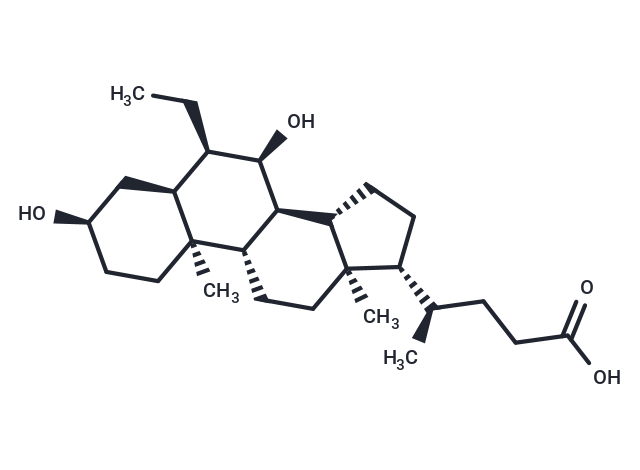Shopping Cart
- Remove All
 Your shopping cart is currently empty
Your shopping cart is currently empty

Obeticholic Acid (6-ECDCA, INT-747) is a high-affinity, semisynthetic, bile acid-derived FXR agonist with an EC50 of 99 nM and is able to upregulate IκB-α, KLF-2, and KLF-4 expression. Obeticholic Acid (6-ECDCA, INT-747) also shows potential for treating hepatic steatosis, inflammation, and fibrosis while increasing insulin sensitivity.

| Pack Size | Price | Availability | Quantity |
|---|---|---|---|
| 5 mg | $41 | In Stock | |
| 10 mg | $48 | In Stock | |
| 25 mg | $75 | In Stock | |
| 50 mg | $101 | In Stock | |
| 100 mg | $166 | In Stock | |
| 200 mg | $288 | In Stock | |
| 500 mg | $531 | In Stock | |
| 1 mL x 10 mM (in DMSO) | $45 | In Stock |
| Description | Obeticholic Acid (6-ECDCA, INT-747) is a high-affinity, semisynthetic, bile acid-derived FXR agonist with an EC50 of 99 nM and is able to upregulate IκB-α, KLF-2, and KLF-4 expression. Obeticholic Acid (6-ECDCA, INT-747) also shows potential for treating hepatic steatosis, inflammation, and fibrosis while increasing insulin sensitivity. |
| Targets&IC50 | FXR:99 nM(EC50) |
| In vitro | METHODS: SCC cells were treated with increasing concentrations of obeticholic acid (6-ECDCA, INT-747) (0-100 μM), hepatocytes and HSCs were seeded at the same density and treated with obeticholic acid (6-ECDCA, INT-747) (0.1, 1 and 10 μM), and finally MTT assay was performed. RESULTS Obeticholic acid (6-ECDCA, INT-747) reduced cell viability by more than 20% at a concentration of 10 μM. [4] |
| In vivo | METHODS: Thioacetamide (TAA)-intoxicated and bile duct ligation (BDL) rats were used as models. Two oral doses of 30 mg/kg obeticholic acid (INT-747) were administered within 24 hours to evaluate in vivo hemodynamics. The effects of short-term obeticholic acid (INT-747) treatment on intrahepatic hemodynamic dysfunction and signaling pathways in different rat models of cirrhotic portal hypertension (PHT) were investigated. RESULTS FXR expression was decreased in both cirrhotic models. Obeticholic acid (INT-747) administration in TAA and BDL reactivated FXR downstream signaling pathways and reduced portal pressure by reducing total IHVR without causing harmful systemic hypotension. Obeticholic acid (INT-747) improved endothelial vasodilation but not hyperresponsiveness in perfused TAA and BDL cirrhotics. [1] METHODS: Animals were fed a low-salt (control) or high-salt diet and treated with obeticholic acid (6-ECDCA, INT-747) (10, 30 mg/kg/day, oral, 6 weeks). Liver lysates were compared for c-JNK1 and 2 expression by Western blot. RESULTS INT-747 reduced hepatic JNK-1 and JNK-2 expression; proinflammatory proteins may be upregulated by a high-salt diet, thereby interfering with normal insulin signaling. [3] |
| Alias | INT-747, 6-Ethylchenodeoxycholic acid, 6-ECDCA |
| Molecular Weight | 420.63 |
| Formula | C26H44O4 |
| Cas No. | 459789-99-2 |
| Smiles | CC[C@H]1[C@@H](O)[C@H]2[C@@H]3CC[C@H]([C@H](C)CCC(O)=O)[C@@]3(C)CC[C@@H]2[C@@]2(C)CC[C@@H](O)C[C@@H]12 |
| Relative Density. | 1.091 |
| Storage | Powder: -20°C for 3 years | In solvent: -80°C for 1 year | Shipping with blue ice. | |||||||||||||||||||||||||||||||||||
| Solubility Information | H2O: < 1 mg/mL (insoluble or slightly soluble) DMSO: 45 mg/mL (106.98 mM), Sonication is recommended. Ethanol: 78 mg/mL (185.44 mM), Sonication is recommended. | |||||||||||||||||||||||||||||||||||
Solution Preparation Table | ||||||||||||||||||||||||||||||||||||
DMSO/Ethanol
| ||||||||||||||||||||||||||||||||||||

Copyright © 2015-2025 TargetMol Chemicals Inc. All Rights Reserved.